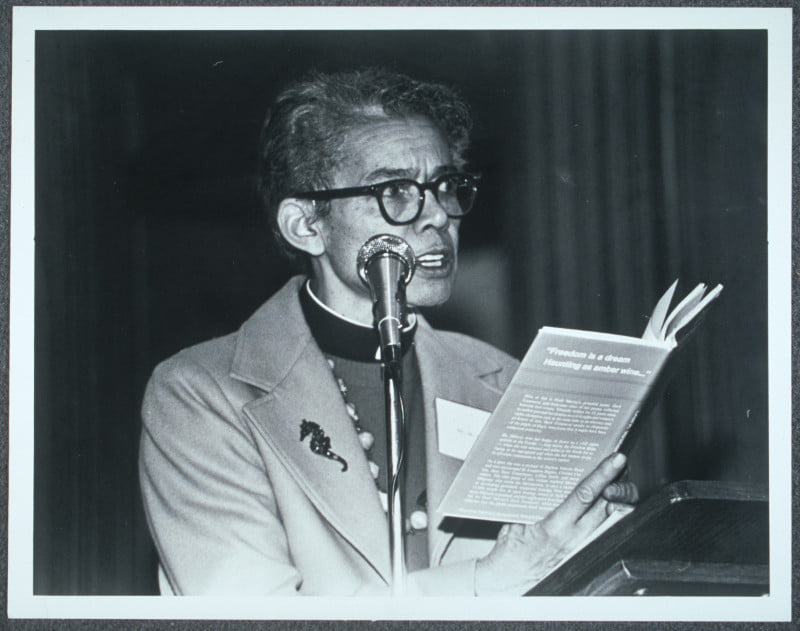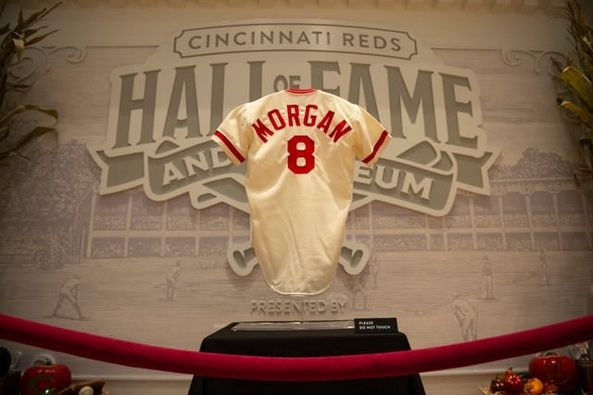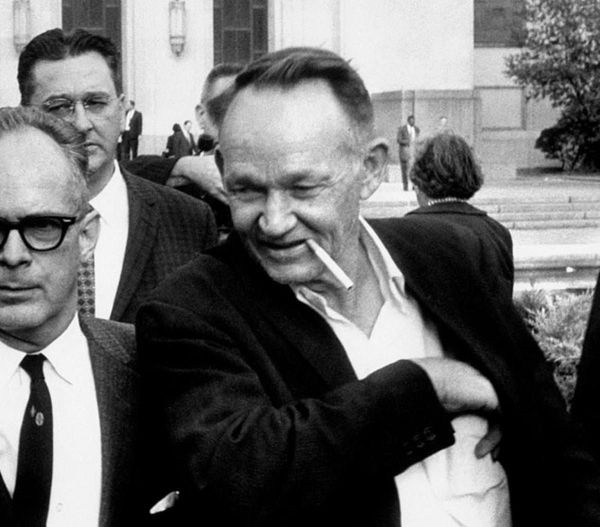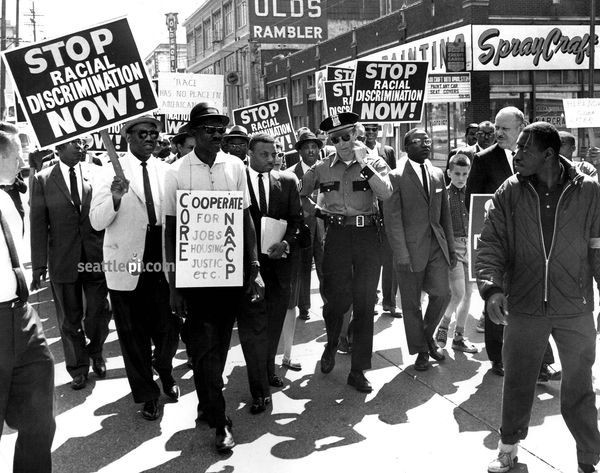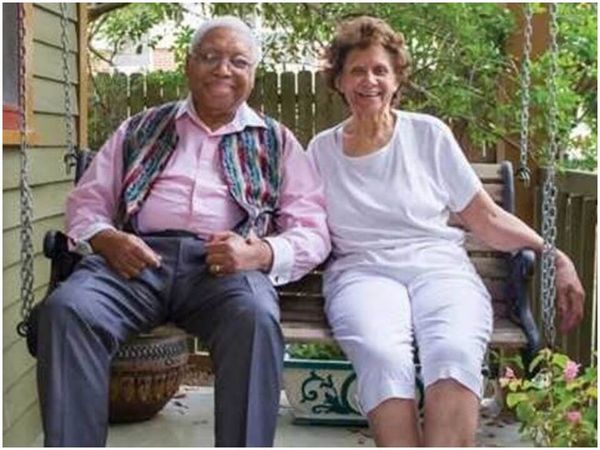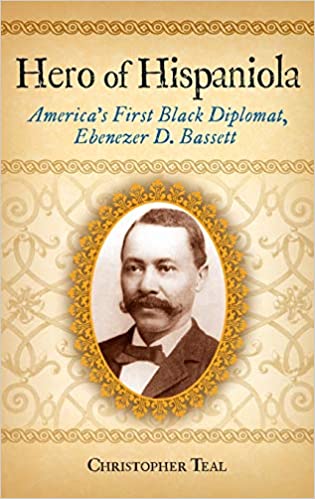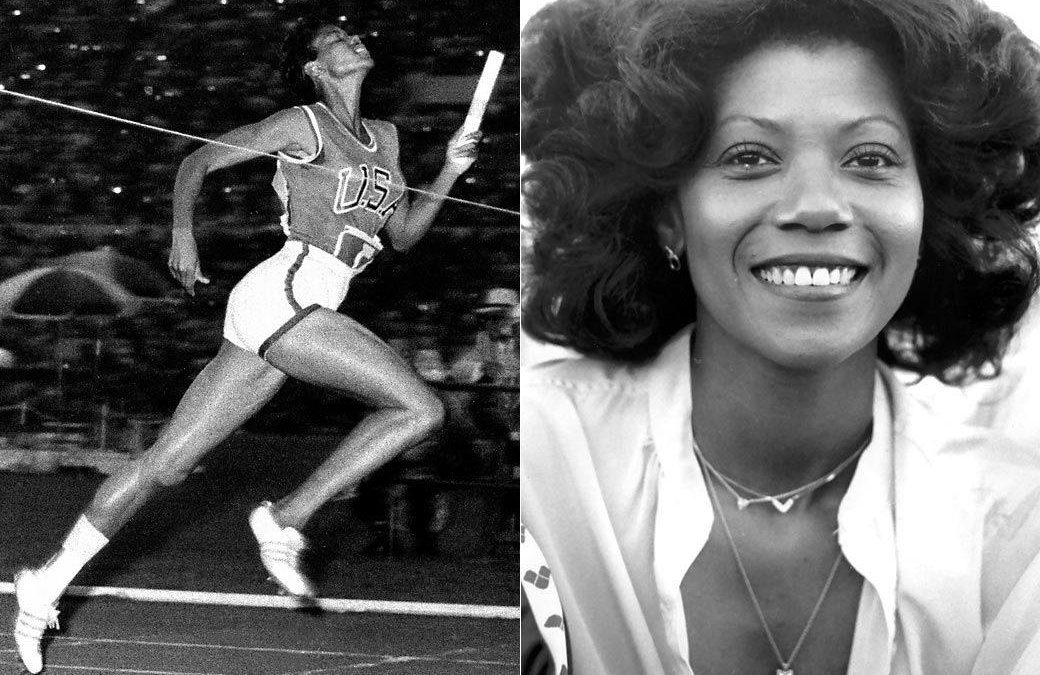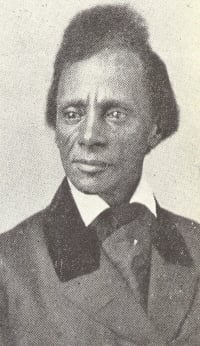GM – FBF – Today’s American Champion was an American civil rights activist who became a lawyer, a women’s rights activist, Episcopal priest, and author. Drawn to the ministry, in 1977 she was the first African-American woman to be ordained as an Episcopal priest, in the first year that any women were ordained by that church.Born in Baltimore, Maryland, she was virtually orphaned when young, and she was raised mostly by her maternal grandparents in Durham, North Carolina. At the age of 16, she moved to New York City to attend Hunter College, and graduated with a Bachelor of Arts degree in English in 1933.In 1940, she sat in the whites-only section of a Virginia bus with a friend, and they were arrested for violating state segregation laws. This incident, and her subsequent involvement with the socialist Workers’ Defense League, led her to pursue her career goal of working as a civil rights lawyer. She enrolled in the law school at Howard University, where she also became aware of sexism.She called it “Jane Crow”, alluding to the Jim Crow laws that enforced racial segregation in the Southern United States. She graduated first in her class, but she was denied the chance to do post-graduate work at Harvard University because of her gender. She earned a master’s degree in law at University of California, Berkeley, and in 1965 she became the first African American to receive a Doctor of Juridical Science degree from Yale Law School.As a lawyer, she argued for civil rights and women’s rights. National Association for the Advancement of Colored People (NAACP) Chief Counsel Thurgood Marshall called her 1950 book, States’ Laws on Race and Color, the “bible” of the civil rights movement. she served on the 1961–1963 Presidential Commission on the Status of Women, being appointed by John F. Kennedy. In 1966 she was a co-founder of the National Organization for Women. Ruth Bader Ginsburg named her as a coauthor of a brief on the 1971 case Reed v. Reed, in recognition of her pioneering work on gender discrimination. This case articulated the “failure of the courts to recognize sex discrimination for what it is and its common features with other types of arbitrary discrimination.” She held faculty or administrative positions at the Ghana School of Law, Benedict College, and Brandeis University.In 1973, she left academia for activities associated with the Episcopal Church. She became an ordained priest in 1977, among the first generation of women priests. She struggled in her adult life with issues related to her sexual and gender identity, describing herself as having an “inverted sex instinct”. She had a brief, annulled marriage to a man and several deep relationships with women. In her younger years, she occasionally had passed as a teenage boy. A number of scholars, including a 2017 biographer have retroactively classified her as transgender. In addition to her legal and advocacy work, she published two well-reviewed autobiographies and a volume of poetry. Her volume of poetry, Dark Testament, was republished in 2018.Today in our History – November 20, 1910 – Anna Pauline “Pauli” Murray was born.Pauli Murray College honors Pauli Murray, a remarkable civil rights and women’s rights advocate, who contributed immensely to the dismantling of segregation and discrimination. Pauli pioneered a vision for a society that valued diversity and rallied around our common human virtues. Pauli Murray College hopes to carry forward her vision for a better society through its community members and its commitment to promoting diversity and inclusion.Born Anna Pauline Murray, she chose to be called the gender non-specific Pauli, and we follow her preference. Pauli was a jurist and activist who contributed some of the legal groundwork to the civil rights movement. Early on in her life, Pauli was committed to pursuing an education and left Durham, NC, as a teenager to attend Hunter College in the 1920s and 1930s. Later, her failed attempt to study at the all-white University of North Carolina garnered national attention and established her as civil rights activist.In 1965, Pauli became the first African-American to receive a JSD degree from Yale Law School. She wrote “Jane Crow and the Law: Sex Discrimination and Title VII” and “Roots of the Racial Crisis: Prologue to Policy,” both of which proved profoundly influential in challenging the legal foundations of racial discrimination.Pauli was a trailblazer throughout her life. She wrestled with her gender identity, and her most intense romantic relationships were with women. She co-founded the National Organization for Women, serving as a vice-president of Benedict College in South Carolina, and becoming the first person to teach African-American Studies and Women’s Studies at Brandeis University. Later in her life, she became the first African-American woman ordained as an Episcopal priest, and received an honorary degree from the Yale Divinity School in 1979.Pauli’s career reveals bravery, persistence, and diligence in her pursuit of an equal society. Her story and achievements continue to inspire the work of scholars and activists today. Research more about this great American Champion and share it with your babies. Make it a champion day!
Author: Herry Chouhan
GM – FBF – Today’s American Champion was an American professional baseball second baseman who played Major League Baseball (MLB) for the Houston Astros, Cincinnati Reds, San Francisco Giants, Philadelphia Phillies, and Oakland Athletics from 1963 to 1984.
GM – FBF – Today’s American Champion was an American professional baseball second baseman who played Major League Baseball (MLB) for the Houston Astros, Cincinnati Reds, San Francisco Giants, Philadelphia Phillies, and Oakland Athletics from 1963 to 1984. He won two World Series championships with the Reds in 1975 and 1976 and was also named the National League Most Valuable Player (MVP) in each of those years. Considered one of the greatest second basemen of all-time, he was inducted into the Baseball Hall of Fame in 1990.After retiring as an active player, he became a baseball broadcaster for the Reds, Giants, ABC, and ESPN, as well as a stint in the mid-to-late ’90s on NBC’s post-season telecasts, teamed with Bob Costas and Bob Uecker. He hosted a weekly nationally syndicated radio show on Sports USA, while serving as a special advisor to the Reds.Today in our History – November 19, 1975 – Joe Leonard Morgan (September 19, 1943 – October 11, 2020) – named the National League’s Most Valuable Player.“I have never seen anyone, and I mean anyone, play better than Joe has played this year.” – Cincinnati Reds manager Sparky Anderson in 1975Comparable in size to early 20th century players at 5-foot-7, 160 pounds, Joe Morgan instead was perfectly suited to the artificial surface game of the 1970s, when he emerged as one of the key cogs in Cincinnati’s Big Red Machine.In the Reds’ back-to-back World Series championship years in 1975-76, Morgan won back-to-back MVP awards in the National League, as well as two of his five consecutive Gold Glove Awards.Morgan signed with the expansion Houston Colt .45s in 1962. He reached the majors for the first time in 1963 and became Houston’s regular second baseman in 1965. He spent nine seasons with Houston and made two All-Star Game appearances, but became a Hall of Famer after being traded in November 1971 to the Reds and leaving Houston’s cavernous Astrodome.Morgan led the league in walks, on-base percentage and runs scored in his first season with Cincinnati and earned All-Star Game nods in each of his eight seasons with the Reds. In his peak years of 1975 and ’76, he twice led all of baseball in OPS (on-base plus slugging percentage.)After leaving the Reds as a 36-year-old free agent following the 1979 season, Morgan remained a key player on winning teams, playing for Houston’s division winner in 1980, playing two productive seasons in San Francisco and then belting 16 homers for Philadelphia’s pennant-winners in 1983. He played his final season in Oakland – where he grew up – in 1984 before embarking on a long career as a broadcaster. He teamed with Jon Miller for 21 seasons on ESPN’s Sunday Night Baseball.Morgan finished his career with 2,517 hits, 1,650 runs scored, 268 home runs, 689 stolen bases and 1,865 walks.Morgan was elected to the Hall of Fame in 1990. He passed away on Oct. 11, 2020. Research more about this great American Champion and share it with your babies. Make it a champion day!
GM – FBF – Today’s American Champion tragedy was, also known as Dynamite Bob, was a white supremacist terrorist convicted in 1977 of murder for his role as conspirator in the 16th Street Baptist Church bombing in 1963.
GM – FBF – Today’s American Champion tragedy was, also known as Dynamite Bob, was a white supremacist terrorist convicted in 1977 of murder for his role as conspirator in the 16th Street Baptist Church bombing in 1963. A member of the United Klans of America, he allegedly also firebombed the houses of several black families in Alabama.Today in our History – November 18, 1977 – Robert Edward Chambliss – a former KKK member is convicted of first degree murder in connection with the 1963 bombing of the 16th Street Baptist Church in Birmingham, AL. that killed four African American Teenage women.A May 13, 1965 memo to Federal Bureau of Investigation (FBI) director J. Edgar Hoover identified Chambliss, Bobby Frank Cherry, Herman Frank Cash and Thomas E. Blanton, Jr. as suspects in the 16th Street Baptist Church bombing that killed four young African-American girls.The investigation was originally closed in 1968; no charges were filed. Years later it was found that the FBI had accumulated evidence against the named suspects that had not been revealed to the prosecutors by order of J. Edgar Hoover. Edgar Hoover stopped and shut down the investigation in 1968.The files were used by Alabama attorney general Bill Baxley to reopen the case in 1971. In 1977 Chambliss was convicted of murder for the bombing and sentenced to several terms of life imprisonment. He died in Lloyd Noland Hospital and Health Center in Birmingham on October 29, 1985, still proclaiming his innocence. He was 81.Chambliss served his time in a prison near Montgomery, AlabamaIn January of 2016, we participated in an international journalism exchange program. That’s where we first met Ousmane Sagara of the West African nation of Mali. He explained to me how there are roads and parks named for Martin Luther King, junior. That prompted me, a year later, to invite him to take part in APR series and documentary on King’s connection to Alabama. That material aired around the 50th anniversary of Dr. King’s assassination. Pat Duggins, News Director, Alabama Public Radio.50 years ago, a bomb exploded at the 16th street Baptist Church in Birmingham. Four young girls were killed in the blast. It would take 14 years before the first Klansman was tried and convicted in the bombing. Robert Chambliss was found guilty of his part in the attack.He wound up at the St. Clair County Correctional Facility, about 40 miles northeast of Birmingham. It’s here where Chambliss wrote letters to his family during his time in prison.The handwritten letters, and the pictures they paint from that time, can now be found with just a short ride down a creaky elevator to the bowels of the Archives Department at the Birmingham Public Library.April 20, 1979Yes Mommie you told me and told me you called the Governor. Mommie I ask you again did you talk to the governor. Did you call my lawyer. What did he say. Wrote the governor a nice 2 1/2 page letter. The reason he sent the Lt. Governor’s staff over her to talk to me tell our little Babby to write one. Put in your letter so it won’t cost her postage.Answer soon, Your loving husband, R.E. Chambliss“Mommie” is Chambliss’ wife.Archivist Jim Baggett has been studying those decade-old letters in detail.“Chambliss is almost entirely focused on himself in these letters,” says Baggett. “There’s a lot of self-pity and he presents himself as a victim and he never acknowledges any involvement in the bombings. There’s no remorse. There’s no acceptance of responsibility at all.”In 1963, Chambliss was better known by his nickname, Dynamite Bob. Prosecutors at the time called him a skilled bomb maker, responsible for several racially motivated attacks in Birmingham, though the number isn’t clear. Baggett says one element was race—not that of his victims. But, rather his own.“His self-worth comes from the fact that there’s this whole other group of people he can look down upon and dominate,” explains Baggett. “So, I think this accounts for a lot of the reason that people like Chambliss reacted so violently to civil rights activity. It wasn’t just an attack on the social system that they lived in that was segregated. It was an attack on their whole self-image, their own self-worth and how they saw themselves.”Other observers of the 16th Street Baptist Church Bombing have a more straightforward assessment of Chambliss.“The thing that I recall most about him is just a deep sense of meanness. Someone who had such a deep hatred.”Doctor Art Dunning is a professor at the University of Alabama. He was one of just a few African Americans to attend the Tuscaloosa campus in 1966, three years after the Stand in the Schoolhouse Door. He agrees white supremacists were threatened by this change in social order, and that’s what spurred the violence.“I do think that Chambliss’s other world saw this sort of social order crumbling where just by hereditary advantage that certain things, I don’t have to do anything just be born in a certain group, I have this distinct advantage. I think that was disturbing to them,” says Dunning.Back at the Birmingham Public Library, Jim Baggett uses a cart to retrieve Chambliss’ letters from a sea of filing boxes. He pulls another one. It’s also addressed to his wife, dated April 25, 1979.“I don’t trust my lawyer. They are giving big meetings all around taking up big collections. What are they doing with the money. He said it’s being put in the bank first national bank in north Birmingham in your name. I can’t sleep but about thirty minutes at the time. I hardly ever lay down till 11 or 12 o’clock. Mommie i got plenty to tell you when and if i ever get out. It would make you all want to kill somebody.”Chambliss wrote dozens of letters over the next six years. He never did successfully get out of prison as he had tried to for as long as he was incarcerated. Chambliss died behind bars in October 1985.There’s still a connection between the prison and the 16th Street Baptist Church Bombing. One of Chambliss’ accomplices, Thomas Blanton, is still serving a life sentence there. Share this with your babies and make it a champion day!
GM – FBF – Today’s American Champion was an American singer-songwriter and actress, sometimes known as the “Queen of R&B”.
GM – FBF – Today’s American Champion was an American singer-songwriter and actress, sometimes known as the “Queen of R&B”. She was noted for bringing a pop music style to R&B music in a series of hit songs for Atlantic Records in the 1950s, such as “So Long”, “Teardrops from My Eyes” and “(Mama) He Treats Your Daughter Mean”. For these contributions, Atlantic became known as “the house that Ruth built” (alluding to the popular nickname for the old Yankee Stadium). She was a 1993 inductee into the Rock and Roll Hall of Fame.Following a resurgence that began in the mid-1970s and peaked in the 1980s, she used her influence to press for musicians’ rights regarding royalties and contracts; these efforts led to the founding of the Rhythm and Blues Foundation. Her performances in the Broadway musical Black and Blue earned Brown a Tony Award, and the original cast recording won a Grammy Award. Brown was a recipient of the Grammy Lifetime Achievement Award in 2016. In 2017, Brown was inducted into National Rhythm & Blues Hall of Fame. She is also the aunt to legendary hip hop MC Rakim.Today in our History – November 17, 2006 – Ruth Alston Brown died.Known as the Queen of R&B, Ruth Brown was a rhythm and blues singer and actress who crusaded for musicians’ rights. Brown was born Portsmouth, Virginia, on January 12, 1928. After a string of unfortunate events, Brown ended up in Washington, D.C. There, important people backed her such as nightclub owner Blanche Calloway (sister of bandleader Cab Calloway) and a Voice of America disc jockey, Willis Conover, who convinced Ahmet Ertegun and Herb Abramson, founders of Atlantic Records, to sign Brown. She made her recording debut in 1949.“Teardrops from My Eyes” was released in 1950. The song became a hit and reached No. 1 on the rhythm and blues chart. Her sound on the single gave her the description of “the girl with the tear in her voice.” This sound came to be known as her signature sound. Brown was Atlantic Record’s first star, and they marketed her as “Miss Rhythm.” She sang the duet “Love Has Joined Us Together” with Clyde McPhatter and toured on bills with him and others such as Ray Charles and Billy Eckstine.Brown left Atlantic Records in the early 1960s after she claimed the label started cheating her. After leaving the record label, Brown experienced more misfortune. She held a series of low-paying jobs as a floor scrubber and bus driver. Soon, she was able to rise from her misfortunes. She began singing club dates in the New York area in the mid-1960s. She recorded an album in 1968 with the Thad Jones-Mel Lewis Big Band and continued her music career.Brown was invited to play the gospel singer Mahalia Jackson in the 1975 musical production of Selma in Los Angeles, California by comedian Redd Foxx. The musical was about civil rights, and Foxx was its producer. Later, she performed in Las Vegas, Nevada. The New York Times describes the rest of her entertainment career as being the “comeback that never ended.”Because of her exploitation by Atlantic Records, Brown became an activist for musicians’ rights. She spoke out on stage and in interviews on the unfair contracts that musicians in her generation had experienced. Because she spoke out, Atlantic waived unrecouped debts held by Brown and thirty-five other musicians of her era and agreed to pay twenty years’ worth of retroactive royalties.Atlantic also contributed almost $2 million to start the Rhythm and Blues Foundation, which pushed for royalty reform and distributed millions of dollars to musicians in need.Brown sustained many relationships throughout her life, having been married three times. She had two sons, Ronnie McPhatter (given the last name Jackson at birth) with Clyde McPhatter, and Earl Swanson with saxophonist Earl Swanson. Her health started to decline near the end of her life.She was able to overcome a stroke in 2000, but ultimately she succumbed to a heart attack and stroke following a surgery at the age of seventy-eight on November 17, 2006. Research more about this great American Champion and share it with your babies. Make it a champion day!
GM – FBF – Today’s American Champion is an American actress and activist.
GM – FBF – Today’s American Champion is an American actress and activist. She played Denise Huxtable on the NBC sitcom The Cosby Show, which originally aired from 1984 to 1992, and starred in its spinoff comedy A Different World for its first season (1987–1988).Today in our History – November 16,1967 – Lisa Michelle Bonet was born.Born in 1967, Lisa Bonet (she changed her name legally to Lilakoi Moon in 1995) is an American actress who starred as free-spirited Denise Huxtable on The Cosby Show. In the latter part of the show’s run, she crossed over and starred in the spinoff A Different World. From 1987 to 1993, she was famously married to rockstar Lenny Kravitz, and together, they have a daughter, actress Zoë Kravitz. Bonet is currently married to Game of Thrones and Aquaman actor Jason Momoa and has two children with him.Lisa Bonet arrives at the premiere of HBO’s ‘Game of Thrones’ Season 6 at the TCL Chinese Theatre on April 10, 2016 in Hollywood, California.Lisa Bonet was born on November 16, 1967 in San Francisco, California. Her father, Allen, is African-American and her mother, Arlene, is Jewish; both have creative backgrounds in music. Bonet’s parents split when she was a baby, and her mother raised her as a single parent in the Los Angeles area.Bonet recalls her experience being a biracial child. “The world wasn’t ready for what I represented, the merging of these two races,” Bonet said in an interview with Porter Edit in 2018. “I didn’t always feel welcome – in my mom’s family, in my school. So I sheltered myself by always withholding a bit, because I didn’t always feel safe.”But Bonet was able to find a sense of safety in the performing arts, and after finishing high school in Van Nuys, California, she decided to major in acting at the Celluloid Actor’s Studio.Bonet’s breakout role was playing daughter Denise Huxtable on The Cosby Show, which she starred in from 1984 to 1992. She took a short break from the show in 1987 to work on the first season of A Different World, which depicted her character, Denise, going off to college.But Bonet was craving more complicated roles than her squeaky clean characters had to offer on network television, and 1987 became a big year of change for Bonet both professionally and personally.Outside of her work on A Different World, Bonet set her sights on the big screen, taking on the sexually racy part of Epiphany Proudfoot in the horror flick Angel Heart, opposite Mickey Rourke. In helping promote the film, Bonet went topless for Interview magazine and responded to the notion of maintaining her wholesome image that she built on The Cosby Show. “My obligation wasn’t to Denise. I felt obligated to myself and my career,” she said.Around this time, Bonet was rumored to be butting heads with television patriarch Bill Cosby by purportedly criticizing the direction of the show and coming in late to work — hence, why she was “encouraged” to work on A Different World.But if anyone found the young Bonet to be difficult, she had more surprises in store. Barely out of her teens, she got engaged to Lenny Kravitz at 20 and was pregnant with their daughter Zoe. Bonet’s pregnancy prevented her from further working on A Different World, and in 1991, she was fired from The Cosby Show.Among her other bigger projects, Bonet starred in Enemy of the State (1998), High Fidelity (2000), Biker Boyz (2003), Whitepaddy (2006) and the television show Life on Mars (2008). More recently, she’s guest starred on her husband Jason Momoa’s Sundance television series The Red Road in 2014 and Showtime’s Ray Donovan in 2016.In November 1987 Bonet married rockstar Lenny Kravitz and a month later gave birth to their daughter Zoë. Although the couple only lasted six years together, Bonet looks back and describes her experience with Kravitz as “a very accelerated time, spiritually and intellectually.”Today, she and Kravitz are good friends, with the latter sharing holidays with her, their daughter Zoë and Bonet’s new family with Jason Momoa.In 2004 Bonet met actor Jason Momoa at a Los Angeles jazz club. The two fell in love and eventually had two children together, daughter Lola Iolani (b. 2007) and later son Nakoa-Wolf (b. 2008). Bonet and Momoa officially married in October 2017 and live in canyon country outside of Los Angeles.About their enduring relationship, Bonet has nothing but praise for Momoa, who is 13 years younger than her. “What’s cool about Jason is that he’s an alpha male who stands for love and family. And to circle back to my own wounds, having an absent father, then to be fully met by a man of that stature, is really incredible,” she said. “Jason embodies a rare form of masculinity in this day and age — he’s a leader; he’s generous. Just in terms of charisma, physique, the right use of power, responsibility, work ethic, you can go down the line.” Research more about this great American Champion and share it with your babies. Make it a champion day!
GM – FBF – Today’s American Champion event, The Southern Negro Youth Congress was established in 1937 at a conference in Richmond, Virginia.
GM – FBF – Today’s American Champion event, The Southern Negro Youth Congress was established in 1937 at a conference in Richmond, Virginia. The Southern Negro Youth Congress consisted of young leaders that participated in the National Negro Congress.The first gathering of the Southern Negro Youth Congress consisted of a wide range of individuals. Such individuals as representatives from almost all the black colleges in the country, Boy and Girl Scouts, young steel workers, and even members of the YMCA all joined together to form the Southern Negro Youth Congress.The Southern Negro Youth Congress felt that the major threat to the role of democracy was not communism or socialism but rather fascism was the biggest threat, not only to the black population but also a major threat to the white population as well. Many members of the Southern Negro Youth Congress felt that it was a great organization because it allowed people to not only settle into the Southern areas but also take action to change it for the better as well.The Southern Negro Youth Congress engaged in many activities during the late 1930s and 1940s such as leading boycotts against discriminatory working environments, registering African-American votes, discussed problems with government officials in Washington, D.C., organized workers into unions and assisted rural African-Americans in legal cases.The Southern Negro Youth Congress performed such studies as taking items being purchased in a black community and then comparing the prices to those same items being purchased in a white community. This study showed that prices for the same goods were 20-30% higher in the black communities than they were in the white communities, which meant that the citizens who were struggling most to survive were actually paying higher prices for the items that were necessary for them to live.Prominent members of the Southern Negro Youth Congress consisted of veteran activists James Jackson, Helen Gray, Esther Cooper Jackson and Edward E. Strong and at one time or another had the support of prominent figures that included Mary McCleod Bethune, Charlotte Hawkins Brown, Franklin D. Roosevelt and William Edward Burghardt DuBois.At its prime the Southern Negro Youth Congress claimed that it represented about 250,000 young black southerners but due to insufficient records these numbers could not be verified. The Southern Negro Youth Congress saw its demise in 1949 in part due to the postwar period of the United States caught in the Cold War as well as fear, hysteria, racial violence and loss of jobs that led to many difficulties for the Southern Negro Youth Congress leaders to solve.Today in our History – November 15, 1974 – The Southern Negro Youth Congress disbands. Few of us know what we should know about the continuity of the movements for full racial equality in the Deep South. Amnesia about black history cuts us off from the past and undermines our self-image and our confidence that we can bring about important, constructive change in the world. I write as a historian whose life and work was inspired by the movements for racial equality in the South during the 1940s. The long civil rights movement in the south was powerful during the 1930s and 1940s. It was an interracial struggle with strong ties to the movements of sharecroppers, small farmers and industrial workers, university professors, students, business people, professionals and intellectuals. I share here some of my memories as a founder and participant in the New Orleans Youth Congress which became closely tied to the Southern Negro Youth Congress. One of SNYC’s greatest achievements after World War II was organizing the Southern Youth Legislature held in Columbia, South Carolina in October, 1946. By 1947 SNYC was destroyed by racist and political terror, the cold war and the Red Scare and largely erased from historical and popular memory.Professional historians have begun to study the massive amount of previously unknown documents about these forgotten movements. I present here what I remember about the Southern Negro Youth Congress during its brief time of triumph after World War II and its sudden collapse in 1947 although it was not formally dissolved until 1949.In the early fall of 1945, shortly after World War II ended, I read an announcement in the New Orleans Times Picayune informing the public that an international youth delegation was returning from the founding conference of the United Nations in San Francisco and stopping in various cities across the United States to establish a new, international youth organization to promote the aims of the United Nations. Everyone at the meeting was white. The delegates announced they had met with Negro youth in New Orleans first and then organized this separate meeting for whites. The Negro youth from their previous meeting walked into the white meeting in a body, sat down, and announced there would be no racially segregated youth organization in New Orleans claiming to support the objectives of the United Nations. Thus was founded the New Orleans Youth Council. It quickly became a large, active interracial organization and functioned under various names for the rest of the 1940s. We met as equals and fought racial discrimination, disenfranchisement and segregation. We had several hundred official and fringe members including students from all the universities in New Orleans, some high school students and young workers who were musicians, merchant seamen, factory workers, homemakers, maids, and business-owners.Many of our members were recently returned veterans of World War II who lived in black housing projects. The black veterans also belonged to the Louisiana Veterans’ Organization. We attended each others’ parties and dances in our offices and homes and went to Afro-Louisiana music clubs, bars and restaurants together all over town. We all stood up together talking, joking, and laughing in the segregated streetcars although there were lots of vacant seats. We picketed the downtown department stores demanding they let African-Americans shop there. The NAACP Youth Council wanted to picket with us, but their parent organization would not allow it.All the full time staff of SNYC were Communist Party members and under its discipline. This created some problems which I will discuss elsewhere. When the New Orleans Youth Council was born in 1945, the Communist Party had dissolved itself the year before and knew nothing about this new, spontaneous youth movement. By 1946 almost all the New Orleans Youth Council officers were recruited into the restored Communist Party of Louisiana. NOYC was ordered dissolved by the Communist Party ostensibly to create a chapter of SNYC instead.By 1947, SNYC was dead. Here’s how it happened. An openly publicized meeting at Carpenter’s Hall in the French Quarter was announced by the Communist Party to introduce James E. Jackson, Jr., Educational Director of SNYC, to the community as the Communist Party’s new District Organizer. The meeting was brief. Police were lined up along the walls.A goon squad (vigilantes) from the Seafarers’ International Union (an all white AFL union) attacked the audience with metal folding chairs. The police waited until the attack was over and arrested only the speakers and the men in the audience, not their attackers. I went to night court to see what became of the men. Judge Edwin Babylon presided. He asked the prisoners to choose a person to be their spokesman. They chose an African-American trade unionist. The judge was shocked, and said, “You mean to say you white people are going to let a nigger speak for you?”Members of the goon squad came looking for James Jackson in his apartment a few days after the trial. He locked himself in the bathroom and picked up the top of the toilet tank to defend himself. The police arrived and charged him with criminal mischief for breaking the toilet! As he left the courtroom, a mob was outside waiting for him. My father, attorney Herman L. Midlo, walked out of the courthouse with Jackson and told the crowd, “I know every one of you and you won’t get away with it if you lay a hand on this man.”The mob let Jackson leave unharmed. He left town shortly thereafter and joined his wife Esther Cooper Jackson and their family in Detroit. By then all of SNYC’s leadership had already retreated north to escape the violence directed against SNYC meetings by Birmingham Police Commissioner T. Eugene “Bull” Connor in Birmingham. Only SNYC founder and leader Louis E. Burnham remained in the South to co-chair former Vice President Henry A. Wallace’s southern campaign for President in 1948. After the presidential race ended with cold warrior Harry S. Truman’s victory, Burnham closed SNYC’s office in Birmingham and left the South. Research more about this great American Champion event and share with your babies. Make it a champion day!
GM – FBF – Today’s American Champion was an American jazz pianist and educator.
GM – FBF – Today’s American Champion was an American jazz pianist and educator. Active since the late 1940s, Marsalis came to greater attention in the 1980s and 1990s as the patriarch of a musical family, with sons Branford and Wynton rising to international acclaim.Remember – “My dad was a giant of a musician and teacher, but an even greater father. He poured everything he had into making us the best of what we could be.” – Brandford MarsalisToday in our History – November 14, 1934 – Ellis Louis Marsalis Jr. was born.Ellis Louis Marsalis Jr. was born on Nov. 14, 1934. He graduated from Dillard University in New Orleans with a B.A. in music education, and that was the field to which he devoted himself. Despite playing with such notable jazz musicians as Cannonball and Nat Adderley, he was most proud of his work as an educator. His music students included Terence Blanchard, Donald Harrison, Harry Connick Jr. and four of his sons: Wynton, Branford, Delfeayo and Jason Marsalis.Ellis Marsalis taught at the first full-time public arts high school in New Orleans, the New Orleans Center for Creative Arts, where he instructed students on the harsh realities of pursuing a career in the arts.The former Marine put it this way to NPR in 1985: “There is no such thing as fair. The world’s not fair, it’s not about being fair.”Marsalis went on to become Commonwealth Professor at Virginia Commonwealth University in Richmond before returning to his hometown to teach at the University of New Orleans. Yet he still managed to record more than 15 albums of his own, in addition to collaborations with his sons.And on top of all that, he played a weekly gig at a small New Orleans club, Snug Harbor Jazz Bistro, for three decades before retiring just this year. Research more about this great Institution and share it with your babies. Make it a champion day!
GM – FBF – Today’s American Champion was an African American who was appointed United States Ambassador to Haiti in 1869.
GM – FBF – Today’s American Champion was an African American who was appointed United States Ambassador to Haiti in 1869. He was the first African-American diplomat and the fourth U.S. ambassador to Haiti since the two countries established relations in 1862.His asset was appointed as new leaders emerged among free African Americans after the American Civil War. An educator, abolitionist, and civil rights activist, Bassett was the U.S. diplomatic envoy in 1869 to Haiti, the “Black Republic” of the Western Hemisphere. Through eight years of bloody civil war and coups d’état there, h served in one of the most crucial, but difficult postings of his time. Haiti was of strategic importance in the Caribbean basin for its shipping lanes and as a naval coaling station.Today in our History November 13, 1908 – Prior to his death, Ebenezer D. Bassett returned to live in Philadelphia, where his daughter Charlotte also taught at the ICY.Ebenezer D. Bassett was appointed U.S. Minister Resident to Haiti in 1869, making him the first African American diplomat. For eight years, the educator, abolitionist, and black rights activist oversaw bilateral relations through bloody civil warfare and coups d’état on the island of Hispaniola. Bassett served with distinction, courage, and integrity in one of the most crucial, but difficult postings of his time.Born in Connecticut on October 16, 1833, Ebenezer D. Bassett was the second child of Eben Tobias and Susan Gregory. In a rarity during the mid-1800s, Bassett attended college, becoming the first black student to integrate the Connecticut Normal School in 1853. He then taught in New Haven, befriending the legendary abolitionist Frederick Douglass. Later, he became the principal of Philadelphia, Pennsylvania’s Institute for Colored Youth (ICY).During the Civil War, Bassett became one of the city’s leading voices into the cause behind that conflict, the liberation of four million black slaves and helped recruit African American soldiers for the Union Army. In nominating Bassett to become Minister Resident to Haiti, President Ulysses S. Grant made him one of the highest ranking black members of the United States government.During his tenure the American Minister Resident also dealt with cases of citizen commercial claims, diplomatic immunity for his consular and commercial agents, hurricanes, fires, and numerous tropical diseases.The case that posed the greatest challenge to him, however, was Haitian political refugee General Pierre Boisrond Canal. The general was among the band of young leaders who had successfully ousted the former President Sylvan Salnave from power in 1869. By the time of the subsequent Michel Domingue regime in the mid 1870s Canal had retired to his home outside the capital. Domingue, the new Haitian President, however, brutally hunted down any perceived threat to his power including Canal.General Canal came to Bassett and requested political asylum. A standoff resulted, with Bassett’s home surrounded by over a thousand of Domingue’s soldiers. Finally, after five-month siege of his residence, Bassett negotiated Canal’s safe release for exile in Jamaica.Upon the end of the Grant Administration in 1877, Bassett submitted his resignation as was customary with a change of hands in government. When he returned to the United States, he spent an additional ten years as the Consul General for Haiti in New York City, New York. Prior to this death on November 13, 1908, he returned to live in Philadelphia, where his daughter Charlotte also taught at the ICY. Bassett was 75 at the time of his death.Ebenezer D. Bassett was a role model not simply for his symbolic importance as the first African American diplomat. His concern for human rights, his heroism, and courage in the face of pressure from Haitians, as well as his own capital, place him in the annals of great American diplomats. Research more about this great American Champion and share it with your babies. Make it a champion day!
GM – FBF – Today’s American Champion was an American sprinter born in Saint Bethlehem, Tennessee, who became a world-record-holding Olympic champion and international sports icon in track and field following her successes in the 1956 and 1960 Olympic Games.
GM – FBF – Today’s American Champion was an American sprinter born in Saint Bethlehem, Tennessee, who became a world-record-holding Olympic champion and international sports icon in track and field following her successes in the 1956 and 1960 Olympic Games. She competed in the 200-meter dash and won a bronze medal in the 4 × 100-meter relay at the 1956 Summer Olympics at Melbourne, Australia. She also won three gold medals, in the 100- and 200-meter individual events and the 4 x 100-meter relay at the 1960 Summer Olympics in Rome, Italy. She was acclaimed the fastest woman in the world in the 1960s and became the first American woman to win three gold medals in a single Olympic Games.Due to the worldwide television coverage of the 1960 Summer Olympics, she became an international star along with other Olympic athletes such as Cassius Clay (later known as Muhammad Ali), Oscar Robertson, and Rafer Johnson who competed in Italy.As an Olympic champion in the early 1960s, she was among the most highly visible black women in America and abroad. She became a role model for black and female athletes and her Olympic successes helped elevate women’s track and field in the United States. She is also regarded as a civil rights and women’s rights pioneer. In 1962 she retired from competition at the peak of her athletic career as the world record-holder in the 100- and 200-meter individual events and the 4 × 100-meter relays. After competing in the 1960 Summer Olympics, the 1963 graduate of Tennessee State University became an educator and coach.She died of brain and throat cancer in 1994, and her achievements are memorialized in a variety of tributes, including a U.S. postage stamp, documentary films, and a made-for-television movie, as well as in numerous publications, especially books for young readers.Today in our History – November 12, 1994 – Wilma Glodean Rudolph died.Wilma Rudolph was an African American Olympic Athlete who competed in the Olympic Games of 1956 and 1960. She was also the first American Woman to win three gold medals in track and field events during a single Olympic Games.Wilma Glodean Rudolph was born on June 23, 1940 in Saint Bethlehem, Tennessee. Weighing a mere 4.5 pounds, Wilma was born premature, and had also instantaneously contracted infantile paralysis; a disease which took her eleven years to fully recover from. Wilma’s compromised immune system also meant that she regularly suffered bouts of polio and scarlet fever due in her early years.After completely recovering from her illness, Wilma started playing basketball for her high school, after which she was discovered by future United States Olympic Head Track and Field Coach, Ed Temple. Rudolph trained extensively under Temple, with whom she built upon her previous track experience from Burt High School. She continued to train under Temple and she consistently improved her record. By the time Rudolph was sixteen; her fastest times were good enough to have her placed in the United States Olympic Track and Field Team of 1956. Rudolph won the bronze medal in the 4x100m relay race in the 1956 Melbourne Olympics alongside Mae Faggs, Margaret Matthews, and Isabelle Daniels.In 1959, when Rudolph was only 19; she went on to win another Gold Medal in the 4x100m relay race, as well as a silver medal in the individual 100m race. She also performed excellently in the Association of American Universities (AAU) tournaments, where she first won an individual 100m race.The 1960 Summer Olympics in Rome would see Rudolph become the first American woman in history to win three gold medals in separate track and field events. Her most impressive feat was to win the 100m race in 11 seconds; however, the time was not accepted as a world record due to the presence of an appreciable tailwind. Nonetheless, Rudolph went on to win the 200m race with an impressive time of 23.2 seconds; this time however, was recorded as the new Olympic Record. Rudolph also won the 4x100m race alongside Martha Hudson, Lucinda Williams, and Barbara Jones in a blistering 44.5 seconds; a new World Record.Wilma Rudolph retired from track and field competitions at twenty two years of age; she last participated at a U.S. – Soviet meet; an event where she won two races. She was granted a full undergraduate scholarship at the Tennessee State University, after which she worked multiple jobs, including working for a community center, and teaching at her childhood school.Rudolph gathered a lot of popularity world over due to his blistering pace. She was nicknamed “The Black Gazelle” by the Italians and “The Black Pearl” by the French.Rudolph received the James E. Sullivan Award in 1961 as a result of her wins in 1960. She was also inducted in the U.S. Olympic Hall of Fame in 1983, as well as the National Track and Field Hall of Fame in 1974. Rudolph was also inducted in the National Women’s Hall of Fame in 1994.Rudolph was diagnosed with a brain tumor in July 1994. She was already suffering from throat cancer at the time. On November 12, 1994, Wilma Rudolph died in Nashville, Tennessee. Her memorial and subsequent funeral was attended by thousands of supporters from all over the country. Research more about this great American Champion and share it with your babies. Make it a champion day!
GM – FBF – Today’s American Champion was an abolitionist who promoted African-American emigration.
GM – FBF – Today’s American Champion was an abolitionist who promoted African-American emigration. He was a traveling speaker, political organizer, and newspaper proprietor. He later became the only black officer to command his own unit during the Civil War.Today in our History – November 11 1865 – Hezekiah Ford Douglas known as H. Ford Douglas died.Captain Hezekiah Ford Douglas was born in Virginia in 1831 to a white man named William Douglas, and an enslaved mother named Mary. He escaped from slavery sometime after his fifteenth birthday, and moved to Cleveland, Ohio.Working as a barber, the self-educated Douglas was active in the free black community of Cleveland, especially its state convention movement. His first state meeting was at Columbus in 1850, at which time Douglas was already gaining attention for his outstanding oratorical talents. He appeared at the Ohio State Convention again 1851 and 1852, arguing that African Americans would never gain equality in the United States, and advocating African American emigration. Douglas supported William Lloyd Garrison’s view that the United States Constitution was a proslavery document because it did not exclusively prohibit slavery. He claimed it was written with the intention of continuing slavery. Douglas also felt African-Americans allowed slavery to continue by remaining in the United States and making themselves subject to the U.S. Constitution.At the 1854 National Emigration Convention, Douglas emerged as a prominent speaker with his defense of emigration. He moved to British-controlled West Canada after the convention and in 1856 became a proprietor of the Provincial Freedom, a Canadian newspaper promoting antislavery and emigrationist principles.Through the newspaper Douglas promoted Canada as a place where blacks could live under a government which protected them. He married Statira Steele in October 1857, with whom he had one child.Douglas returned to Chicago in 1858, where he continued to support the emigration movement, which now promoted emigration to Africa, Haiti, and Central America.After a trip to New England in May 1860 at the invitation of Parker Pillsbury, Douglas became an abolitionist speaker. He shocked many in his audience with open calls for violence to end slavery, and spoke about it increasingly after 1860. He continued to promote his belief that it was the presence of slavery, rather than belief in racial inferiority, that facilitated the discrimination against free blacks.After encouraging slaves from Missouri to escape to freedom at the outbreak of the Civil War, Douglas joined the Union Army, enlisting as a private in Company G of the 95th Regiment Illinois Infantry Volunteers on July 26, 1862. In April 1863, Douglas was granted permission to raise his own independent company of black soldiers, and was assigned to the 10th Louisiana Regiment of African Descent (Corps d’Afrique) in June 1863. He became one of less than thirty black commissioned officers during the Civil War and the only African American man to raise and command his own company.Douglas became infected with malaria while stationed in Mississippi, and returned to Chicago to recover. When he returned to the military in July 1864, Douglas recruited and became captain of an independent battery of light artillery in Kansas. Still suffering from malaria a year later, Douglas was forced to leave the service again. He died on November 11, 1865, in Atchison, Kansas. Research more about this great American Champion and share it with your babies. Make it a champion day!

